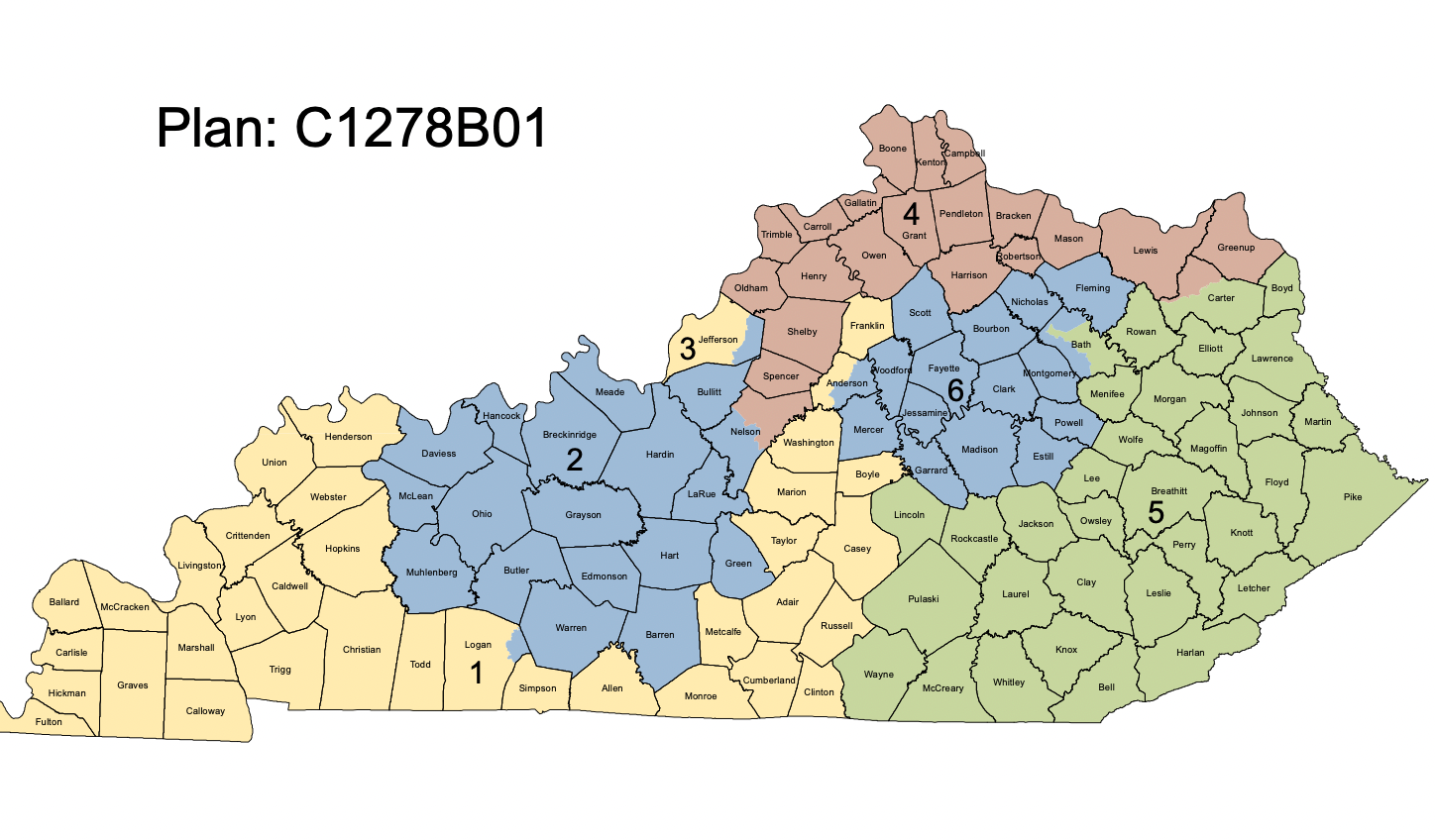The redistricting case: What does it mean for Kentucky?
Published 8:36 am Wednesday, September 27, 2023

- Kentucky's current Congressional districting map, in place since 2022. It was drawn by a majority Republican legislature.
Former State Rep. Buddy Wheatley won his first two elections handily.
In 2018, the Democrat won his District 65 seat with 58% of the vote. In 2020, he increased the gap with 60% of the Covington area vote.

Former State Rep. Buddy Wheatley speaks to the crowd at Fancy Farm in August ahead of his campaign for Kentucky’s Secretary of State.
2022 was different. Wheatley lost to Republican challenger Stephanie Dietz by two percentage points.
He attributes it to gerrymandering.
Every decade, the Kentucky legislature redraws its electoral maps in light of population changes recorded by the U.S. Census.
The maps usually end up in court, based on claims that the party in power redistricted to create an unfair advantage for itself.
Kentucky’s most recent redistricting is no exception. The maps are now in the hands of the Kentucky Supreme Court, which heard oral arguments in the case recently.
How did we get here?
In 2022, the majority Republican legislature passed new State House, State Senate and Congressional maps in House Bill 2, Senate Bill 2 and Senate Bill 3, respectively.
Immediately after Gov. Andy Beshear’s vetoes of the maps were overridden, the Kentucky Democratic Party, Rep. Derrick Graham and several voters filed a lawsuit against the State Board of Elections and Secretary of State Michael Adams in Franklin County Circuit Court.
The plaintiffs argued that the legislature’s maps were an example of partisan gerrymandering, the practice of drawing districts in a way designed to benefit one party’s electoral chances over another’s.
Gerrymandering commonly leads to weirdly-shaped districts when one party tries to include or exclude certain areas and populations.
Last November, the Franklin Circuit Court ruled in favor of the Commonwealth.
Franklin Circuit Court Judge Thomas Wingate said that while it was “abundantly clear” that the state House and congressional maps were partisan gerrymanders, it was up to the Kentucky Supreme Court to determine whether the Kentucky Constitution prohibits partisan gerrymandering.
While the ruling was a technical win for Republicans, University of Kentucky Political Science Professor Stephen Voss said that Wingate’s opinion was favorable to the Democrats.
“Wingate’s opinion was a screaming invitation to the state Supreme Court to declare partisan gerrymandering unconstitutional so that those maps could get tossed out,” Voss said.
The case is now at the state’s highest court.
Oral Arguments
Much of the court discussion revolved around Section 33 of the Kentucky Constitution. Section 33 contains a dual mandate for redistricting. First, it requires population equality across districts to ensure that every person’s vote holds relatively equal weight, with a 5% buffer area.
Second, it asks for county integrity, which means keeping a county together if possible.
In this case, all maps meet the population equality requirement. But Democrats argue that the Republican’s state House maps split counties more than necessary.
While Kentucky’s political geography makes it impossible to not split any counties — the minimum number of split counties is 23 — HB2 splits these already split counties 80 times, while the Democratic alternative split them 60 times.

Kentucky’s last districting map, in place from 2012 to 2022. It was drawn by a majority Democrat State House.

Kentucky’s current districting map, in place since 2022. It was drawn by a majority Republican legislature.
Using mapping technology and statistical analysis, the plaintiffs compared the Republican’s maps to thousands of simulated maps to show that the Republican maps were outliers in numbers of multi-split counties.
KDP Attorney Michael Abate said that while his side understands that sometimes trade-offs are made to comply with other Section 33 requirements, the Republicans offered no reasonable explanation.
“For example, I’m going to bisect this county more times to minimize the number of times I have to combine three, I’m gonna allow this border to be crossed an extra time because we made this trade off,” Abate said. But “did they do it consistently across the state and was it in an equal effect?”
Abate added that SB3’s Congressional map is clearly intended to benefit U.S. Rep. James Comer with its non-compact, hook-shaped first congressional district that runs 350 miles from Fulton County to Franklin County.

Kentucky’s Congressional districting map, in place from 2012 to 2022.

Kentucky’s current Congressional districting map, in place since 2022. It was drawn by a majority Republican legislature.
The Republican response
The Commonwealth’s defense, Deputy Attorney General Victor Maddox, did not deny that the maps were split more than necessary. He said that Democrats did the same for the near-century they were in power.
Maddox added that the changes to the so-called “Comer hook” were “slight.”
He argued that the Democrats’ map wouldn’t have made a significant difference in how many seats the Republicans won, and that partisan gerrymandering was not expressly prohibited in the state constitution.
Secretary Adams echoed this in remarks after the court adjourned.
“Our position is that the constitution doesn’t speak to this issue at all. If it did, why’d the Democrats gerrymander their maps for 100 years?” he said. “So my view is this is a matter in the constitution left up to the legislature, and they can use their own standards as long as they comply with the Voting Rights Act.”
The Kentucky Supreme Court has not indicated when Kentuckians can expect a ruling in the case.
Wheatley’s story
Wheatley’s former district changed in the 2022 redistricting maps. District 65, which was historically concentrated around Covington, was extended further south to include Fort Wright, Edgewood and Crestview Hills.
Wheatley, who is now running for secretary of state, said these new areas are more Republican leaning and have higher turnout than the Democrat leaning precincts that won him his seat his first two elections.
“The general personality of the district changed, and that takes quite a bit of adjustment if you are the elected official of that district,” he said.
After the legislative overrode Beshear’s veto, the maps immediately went into effect, meaning Wheatley had less than a year to get to know his new constituents before the November 2022 election.
“It takes time,” he said. “You have to do it in a multitude of ways. Attending events in the area to get to know the public officials in the area … so that we can be on the same page about the interest of the citizens in those cities.”
In court, Abate said the redistricting complicated KDP’s recruitment efforts, with geographical changes leading to several dozen uncontested elections.
KDP Spokesperson Anna Breedlove said in a statement that the maps diluted the votes of hundreds of thousands of Kentuckians.
“The Republican majority in Frankfort worked behind closed doors to pick who they represent, rather than allowing Kentucky voters to decide who represents them,” she said. “These politicians drew up maps that cut up communities to stack the deck in their favor and beat incumbents that they knew they couldn’t beat in an election.”
Wheatley said that the impact on Kentucky depends on how far the court goes with its ruling.
But he hopes that this case leads to an independent redistricting commission, a citizen-driven group responsible for drawing electoral maps to present to the legislature for approval.
“About half of the states have gone to an independent redistricting commission to draw their maps with some success, and sometimes those maps are challenged themselves,” Wheatley said. “But this is the best solution.”
What could this mean for Kentucky?
The state Supreme Court could rule in a way that has little impact on the legislative environment and doesn’t explicitly answer the partisan gerrymandering question, Voss said.
It could make the compact district requirement a bit stronger, for example, to avoid some of the weird shapes caused by gerrymandering. It could tell the legislature to split counties fewer times.
Or, it could strike the congressional map down solely based on the shape of the non-compact Comer hook.
“It’s a much more modest departure from past law than would be taking a word like ‘fair elections’ and reading into such vague language this massive doctrine that all of a sudden they’ve discovered that the Constitution doesn’t allow parties to draw maps that help their electoral chances,” he said.
Voss said it’s likely that elected judges won’t want to go too far and risk losing voters.
“The congressional maps are widely criticized, they might want to strike those down, but they might not want to do so in a way that’s going to be seen as radical or is a clear case of judicial activism,” he said.
Even if Democrats win the case, they might only gain a few seats.
Voss said he thinks the case is less about the significance for Kentucky, and more about what it means on the national stage.
Kentucky is part of a broader national effort to build momentum around partisan gerrymandering to convince the U.S. Supreme Court to reconsider its ruling that left the question of legality to the states, he said.
He added that partisan redistricting matters less than it might seem, since voters can be unpredictable.
For example, while Democrats gerrymandered the 2012 maps in their favor a decade ago, they lost many of their legislative seats anyway as the state’s political landscape changed.
“Voters who are voting Republican in one election can turn and bite the Republicans on the heel in the next election,” Voss said.
“They do that sort of thing regularly. When you look at past attempts by parties to manipulate maps to help themselves, those things backfire much of the time.”

